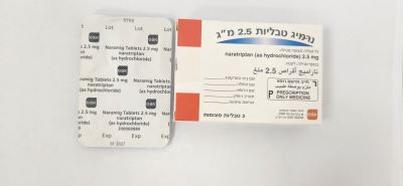Quest for the right Drug

נרמיג טבליות 2.5 מ"ג NARAMIG TABLETS 2.5 MG (NARATRIPTAN AS HYDROCHLORIDE)
תרופה במרשם
תרופה בסל
נרקוטיקה
ציטוטוקסיקה
צורת מתן:
פומי : PER OS
צורת מינון:
טבליות מצופות פילם : FILM COATED TABLETS
עלון לרופא
מינוניםPosology התוויות
Indications תופעות לוואי
Adverse reactions התוויות נגד
Contraindications אינטראקציות
Interactions מינון יתר
Overdose הריון/הנקה
Pregnancy & Lactation אוכלוסיות מיוחדות
Special populations תכונות פרמקולוגיות
Pharmacological properties מידע רוקחי
Pharmaceutical particulars אזהרת שימוש
Special Warning עלון לרופא
Physicians Leaflet
Pharmacological properties : תכונות פרמקולוגיות
Pharmacodynamic Properties
5.1 Pharmacodynamic properties Mechanism of action Naratriptan has been shown to be a selective agonist for 5 hydroxytryptamine1 (5- HT1) receptors mediating vascular contraction. This receptor is found predominantly in intracranial (cerebral and dural) blood vessels. Naratriptan has high affinity for human cloned 5-HT1B and 5-HT1D receptors, the human 5-HT1B receptor is thought to correspond to the vascular 5-HT1 receptor mediating contraction of intracranial blood vessels. Naratriptan has little or no effect at other 5-HT receptor (5-HT2, 5-HT3, 5- HT4 and 5-HT7) subtypes. Pharmacodynamic effect In animals, naratriptan selectively constricts the carotid arterial circulation. This circulation supplies blood to the extracranial and intracranial tissues such as the meninges, and dilatation and/or oedema formation in these vessels is thought to be the underlying mechanism of migraine in man. In addition, experimental evidence suggests that naratriptan inhibits trigeminal nerve activity. Both these actions may contribute to the anti-migraine action of naratriptan in humans. Clinical efficacy and safety In man, a meta-analysis of BP recordings in 15 studies showed that the population average maximum increases in systolic and diastolic blood pressure after a 2.5mg dose of naratriptan tablets would be less than 5mmHg and 3mmHg respectively. The blood pressure response was unaffected by age, weight, hepatic or renal impairment.
Pharmacokinetic Properties
5.2 Pharmacokinetic properties Absorption Following oral administration, naratriptan is rapidly absorbed with maximum plasma concentrations observed at 2-3 hours. After administration of a 2.5mg naratriptan tablet Cmax is approximately 8.3ng/mL (95% Cl: 6.5 to 10.5ng/mL) in women and 5.4ng/mL (95% Cl: 4.7 to 6.1ng/mL) in men. The oral bioavailability is 74% in women and 63% in men with no differences in efficacy and tolerability in clinical use. Therefore a gender related dose adjustment is not required. Distribution Naratriptan is distributed in a volume of 170L. Plasma protein binding is low (29%). Biotransformation Mean clearance after intravenous administration was 470mL/min in men and 380mL/min in women. Renal clearance is similar in men and women at 220mL/min and is higher than the glomerular filtration rate suggesting that naratriptan is actively secreted in the renal tubules. Naratriptan is predominantly excreted in the urine with 50% of the dose recovered as unchanged naratriptan and 30% recovered as inactive metabolites. In vitro naratriptan was metabolised by a wide range of cytochrome P450 isoenzymes. Consequently significant metabolic drug interactions with naratriptan are not anticipated (see section 4.5). Elimination The mean elimination half-life (t1/2) is 6 hours. Special Patient Populations Elderly In healthy elderly subjects (n=12), clearance was decreased by 26% when compared to healthy young subjects (n=12) in the same study (See Posology and method of administration). Gender The naratriptan AUC and Cmax were approximately 35% lower in males compared to females however, with no differences in efficacy and tolerability in clinical use. Therefore a gender related dose adjustment is not required (see Posology and method of administration). Renal impairment Renal excretion is the major route for the elimination of naratriptan. Accordingly exposure to naratriptan may be increased in patients with renal disease. In a study in male and female renally impaired patients (creatinine clearance 18 to 115mL/min; n=15) matched for sex, age and weight with healthy subjects (n=8), renally impaired patients had an approximately 80% increase in t1/2 and an approximately 50% reduction in clearance (See Posology and method of administration). Hepatic impairment The liver plays a lesser role in the clearance of orally administered naratriptan. In a study in male and female hepatically impaired patients (Child-Pugh grade A or B n=8) matched for sex, age and weight with healthy subjects who received oral naratriptan, hepatically impaired patients had an approximately 40% increase in t1/2 and an approximately 30% reduction in clearance (See Posology and method of administration).

שימוש לפי פנקס קופ''ח כללית 1994
לא צוין
תאריך הכללה מקורי בסל
לא צוין
הגבלות
לא צוין
מידע נוסף
עלון מידע לצרכן
08.07.21 - עלון לצרכן אנגלית 08.07.21 - עלון לצרכן עברית 08.07.21 - עלון לצרכן ערבית 05.06.23 - עלון לצרכן עברית 17.07.23 - עלון לצרכן אנגלית 17.07.23 - עלון לצרכן עברית 17.07.23 - עלון לצרכן ערבית 04.01.24 - עלון לצרכן אנגלית 17.03.14 - החמרה לעלון 05.03.15 - החמרה לעלון 05.02.17 - החמרה לעלון 20.01.21 - החמרה לעלוןלתרופה במאגר משרד הבריאות
נרמיג טבליות 2.5 מ"ג